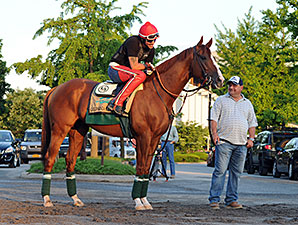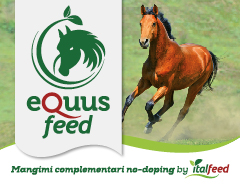‘Chrome’ Becomes Poster Boy for CA Breeders

On the verge of making Triple Crown history, California Chrome has been a tremendous morale booster for a state breeding and racing program left reeling by its downward spiral for several years.
“A horse like California Chrome really increases our visibility,” said Doug Burge, president of the California Thoroughbred Breeders Association. “Even his name is an advertisement for our breeding program. I’m so glad they selected that name for him. You should have seen some of the other names on the list.”
Such as SeaBisquick, which was one of the other possible names on the owners’ short list. Cute, but not quite the same ring.
The charismatic chestnut carries the state’s pride as the first California-bred to win the Kentucky Derby Presented by Yum! Brands and Preakness (both gr. I). Excitement over the potential of such an unlikely Triple Crown winner has put horse racing back on the front page in newspapers from San Diego to Sacramento. California Chrome is the talk of the state.
His humble roots as the product of an inexpensive mare and $2,500 stallion give hope to the everyday horseman. So do his novice owners and breeders, Steve Coburn and Perry Martin, a pair of working class guys. More importantly, they’re lifelong racing fans who crossed over to become part of the sport they love. California Chrome, the first horse they ever bred, is the product of their budget-minded operation.
SHINAR: California Chrome was Flashy from the Start
“This is huge for California breeding,” Coburn said after the Derby. “There’s a lot of good mares in California, and there’s a lot of good sires and people (who care for the horses). Even though the price tag on breeding to some of these sires isn’t like it is in Kentucky or anywhere else, there are some good horses out there. And all you have to do is go back three or four generations, go back a little further in these bloodlines…and you could get a horse just like we have.”
That’s the sort of thinking the CTBA had when it launched the Golden State Series in 2012. After recently adding a pair of $100,000 stakes to the summer fair schedules at Pleasanton and Fresno to this season’s slate, California is now offering 36 added-money events for state-breds approaching a total value of $6 million. The program is funded through a share of purses, track contributions, and foal and stallion nomination fees, Burge said.
On a six-stakes win streak, California Chrome got to this point by following conditions, one step at a time, that were to his advantage as a Cal-bred. As he developed through fall 2013 and winter 2014, he benefited from a maiden bonus program for state-breds as well as other incentives for his owners, and stuck to the Golden State Series before tackling open company. A seasoned runner by the time he started on that path in last March’s San Felipe Stakes (gr. II), he hasn’t lost since.
NOVAK: California Chrome Gallops in Cal Cup Derby
“Obviously, it was very significant for our whole breeding program and for Harris Farm (where California Chrome was conceived, foaled, and raised),” Burge said of the colt’s emergence on the national level. “It was a tremendous boost.
“The Golden State Series races set him up for the open graded stakes and the Kentucky Derby. It’s exactly what we hoped to have happen when we put this program together. He went right through our Cal-bred stakes and into open stakes and we’ve seen what he’s done since then.”
It will be a few years before it will be clear what effect, if any, California Chrome’s success will have on the state’s breeding picture, but Burge and others are convinced it will inspire.
“We’re the ‘Sport of Kings’, but this (the California Chrome story) goes to show that anyone can get into the game and have success,” said Joe Morris, president of the Thoroughbred Owners of California. “I think this is absolutely going to invigorate Thoroughbred ownership and our breeders.”
There’s more good news: After several years of decline, Burge said he is expecting to see a modest increase in the number of mares bred in the state next year. According to The Jockey Club, mares bred annually had fallen from around 5,800 as recently as 2004 to 2,353 in 2013. Those numbers have stabilized in recent years, as has the state’s foal count, which numbered 1,685 in 2012, and Burge notes that California’s dip isn’t very different from what racing nationwide has experienced during and after the economic recession.
California’s small-time breeders are inclined to race in the state, and incentives such as the Golden State Series and maiden bonus program (an additional $17,500 to purses in Southern California, and $10,000 more in the north) are designed to get them back in the game after they retreated during the economic downturn, Burge and others said.
State-breds account for roughly half the starters in California Thoroughbred racing and, on average, 2.5 races for Cal-breds are carded for each program. That underscores the importance of a resurgence in local breeding.
“We’d be in big trouble without them,” Morris said.
California Chrome’s success has certainly had a big impact on his sire, 13-year-old Lucky Pulpit .
Lucky Pulpit led the California freshman sire list in 2010 despite being represented by only 10 runners. The Harris Farms stallion has just 99 foals in his first four crops of racing age but has 62 juveniles coming to the track this year, the progeny of mares attracted by the stallion’s early success with multiple stakes winners such as Luckarack($535,545 in earnings) and Rousing Sermon ($735,092 in earnings, eighth in 2012 Kentucky Derby) in his first two crops.
“Lucky Pulpit has been a very popular stallion in the past several years,” said Dave McGlothlin, horse division general manager at Harris Farms. “He had a book of 70 mares two years ago, 114 last year. He’s gotten good support from California breeders.”
Lucky Pulpit is currently leading the California general sire list, and that sort of success means he’s due for an upgrade. Standing as the property of Larry Williams, he came into the 2014 season with a $2,500 stud fee but that was bumped to $10,000 for his final 14 matings of the year. A decision on his fee for 2015 is likely to be made in September or October, McGlothlin said, but his top-end book will likely remain at 125 mares.
Dan Kiser, manager of the racing and breeding program for Larry and Marianne Williams at their farm in Parma, ID, about 45 miles west of Boise, says he hopes Lucky Pulpit doesn’t get too big for California. Williams has supported his stallion with a number of his own mares and has taken advantage of the state’s lucrative incentive program.
“I’m sure Mr. Williams has talked to some people about possibly moving him out of California,” he said of the son of Pulpit. “But we would love to stay in California with him if we possibly can. Harris Ranch has done such a great job of promoting him.”
Lucky Pulpit has moved to the head of a California sire list that is in transition. Longtime leaders such as In Excess and Bertrando have died, and others such as Benchmark and Cee’s Tizzy are pensioned. While Unusual Heat, at 24, remains amazingly fertile at Harris, according to McGlothlin, the industry suffered a blow shortly before the Kentucky Derby when Tribal Rule died of a heart attack.
In their place could be new sires such as Coil , Richard’s Kid ,Eddington , and Smiling Tiger .
Traditionally, California stallions offer many of the same bloodlines as their Kentucky brethren, but at a much lower fee. Before launching into horse breeding, Perry Martin—California Chrome’s co-owner and breeder—methodically studied nicks and possible combinations offered by California sires for his only mare, Love The Chase.
Despite most descriptions of California Chrome’s humble mother, she had some class. A Maryland-bred daughter of Not for Love , Love the Chase was purchased for $30,000 at the 2008 Fasig-Tipton Midlantic 2-Year-Olds Sale by trainer Greg Gilchrist for the Blinkers On Syndicate. As members of the syndicate, Martin and Coburn each purchased a 5% share in the filly.
HAMMONDS: California Chrome Boasts Maryland Connection
But Love the Chase had issues that kept her from reaching her potential on the track, Martin said. She had breathing problems due to an entrapped epiglottis. She panicked in the paddock before races. She was small.
At Golden Gate Fields, she reached the pinnacle of her six-race career when she won a $8,000 maiden claimer. After she made two lackluster starts versus winners, Martin and Coburn each had the same idea: Buy her and breed her. They became partners and purchased Love the Chase from the syndicate for $8,000.
In her pedigree, Love the Chase has the great mare Numbered Account on both sides, Martin noted. Coincidentally, Numbered Account is a granddaughter of Swaps, the 1955 Kentucky Derby winner and a Cal-bred. Her bloodlines also include Mr. Prospector, Northern Dancer, Danzig and Sir Ivor.
On the sire side, Martin really likes sons of Pulpit; their pedigrees exude so much class, he said. As a son of Pulpit, Lucky Pulpit traces back to A.P.Indy, Seattle Slew and Secretariat. On the dam’s side, this California stallion boasts some turf potential in Cozzene.
Martin felt confident that his first attempt at breeding would produce a horse that could get distance and maybe have a future on turf, too. So far, California Chrome keeps proving him right.
Read more on BloodHorse.com




